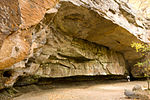Doodlebug disaster
1940 disasters in the United States1940 in OhioAccidents and incidents involving Pennsylvania RailroadCuyahoga Falls, OhioJuly 1940 events ... and 2 more
Railway accidents and incidents in OhioRailway accidents in 1940
The Doodlebug disaster was a railway accident that occurred on July 31, 1940, in Cuyahoga Falls, Ohio, in the United States. A Pennsylvania Railroad, gasoline-powered "doodlebug" passenger rail car collided head-on with a freight train; the impact and resulting fire caused the deaths of all but three of the 46 onboard.
Excerpt from the Wikipedia article Doodlebug disaster (License: CC BY-SA 3.0, Authors).Doodlebug disaster
Front Street, Cuyahoga Falls
Geographical coordinates (GPS) Address Website Nearby Places Show on map
Geographical coordinates (GPS)
| Latitude | Longitude |
|---|---|
| N 41.1461 ° | E -81.472866666667 ° |
Address
Ryes and Shine
Front Street 2704
44221 Cuyahoga Falls
Ohio, United States
Open on Google Maps







